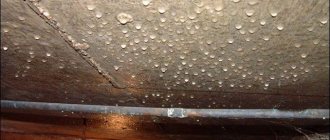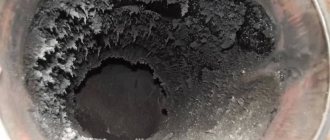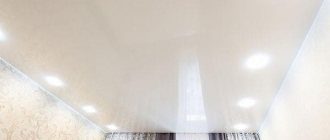There is condensation on the ceiling in the cellar. A good cellar should always have a stable temperature of 2-7°C and a humidity of 75-80%. In such conditions, vegetables stored in it are stored best: they do not sprout, do not rot, and do not dry out. But there is also the other side of the coin - condensation often appears on the ceiling in the cellar, especially in winter, when the outside temperature is much lower than in the cellar. Why does condensation appear in the cellar or basement and how to get rid of it?
Causes of condensation
The appearance of small drops on the walls and ceiling of the cellar is explained simply: they form on surfaces whose temperature is lower than the air temperature in the room.
At the same time, the air humidity is quite high and the basement can become damp both in winter and in summer. Condensation accumulates on the floor and walls if the room above the cellar is heated, making the air temperature in it higher. But even if the basement above is empty, drops cannot be avoided: the ceiling will be covered with them due to the fact that its surface is colder than the air inside.
What are the dangers of constant dampness? First of all, the occurrence of mold: the fungus is harmful to both humans and buildings. Over time, it destroys concrete and wooden floors, walls, floors, and also spoils food stored in the cellar.
Condensation forms if:
- There is no ventilation or it is not working properly.
- The basement is poorly insulated.
- High groundwater level and errors in the construction of the drainage system.
- There are cracks in the foundation of the house.
- There is no waterproofing on the walls and floor.
- Communication systems are leaking.
Strengthening beams
How to connect LED ceiling lights. How to install lamps in a suspended ceiling
This solution to the problem is used when there is no danger of the vegetable storage roof collapsing, and the walls are still able to take on a significant load and not collapse. The most common case in which the ceiling above the cellar has caved in and needs repairs is rotten or load-bearing joists that have just begun to rot. They can be replaced or strengthened and this is done in several ways:
- Installation of supports that will straighten the curved surface and take on part of the load.
- Installation of additional power structures parallel to the old ones.
- Dismantling the roof of the room from above and partially dismantling the existing floor joists and replacing them with new ones.
- Reinforcing the logs installed during the construction of the cellar with overlays made of wood or metal.
The first option is the simplest - you need to install several supports in those places where the deflection of the ceiling is most noticeable. Before inserting the supports, the sagging surface must be raised and leveled, and the supports must be installed at such a height that the plane after their installation is level. To distribute the load more evenly, it is necessary to mount a support platform made of metal or wood at the point of contact of the rack with the surface.
Additional power elements are mounted next to the sagging ones, at some distance. You will need to either install supports along the edges of the room on which they will lie, or make additional holes in the load-bearing wall to insert the ends of additional beams. The operation is very labor-intensive and requires certain skills in construction.
It is not always possible to dismantle the roof of this structure. Therefore, this repair option is most often not used. Otherwise, the technology for restoring floors will be similar to building a new storage facility for vegetables - all stages of roof construction will be identical.
It is much easier to strengthen existing power elements with overlays. To do this, it is necessary to support the existing joists with temporary supports so that the ceiling is level. After this, the linings are mounted on both sides of the reinforced log - on the sides or below and above. They can be made of wood, and in this case, they are bolted all the way through, and also tied on the outside with wire. The linings must have the length of the reinforced log.
If you use a metal corner or metal plates, you need to fasten them according to the same scheme. However, the difference here is that the metal must first be drilled and the holes in the beam must be made exactly in accordance with them. If drilling the joist itself is not possible, then the lining is secured with metal clamps.
How can you tell if the moisture level is high?
You cannot store food supplies in a damp cellar: vegetables without airtight packaging will quickly rot. In addition to the obvious signs of high humidity - condensation on surfaces, puddles on the floor, an unpleasant musty smell, darkening of ceilings due to mold - there are other ways to determine this indicator.
The easiest way is to use a special device, a hygrometer. In a concrete basement, the optimal humidity should be like in a refrigerator - 85-95%.
If you don’t have a hygrometer, you can resort to traditional methods:
- Go down to the cellar with a lit candle. The flame in a dry room will move, and a crimson halo will appear around it. If the basement is humid, the flame will remain straight and stationary.
- Place wood chips on the vegetables, and after a day try to break them. In a dry basement, the wood chip will break with a crash; in a damp basement, it will bend. A silently broken sliver will show the optimal moisture content.
- Pour water into a glass bottle and put it in the refrigerator for a day. Move it to the basement. If the surface of the glass is dry, the basement is dry. If condensation forms on it, the humidity is increased. An indicator of an optimal microclimate is the absence of any changes on the bottle.
Possible consequences
If condensation collects intensely enough, it can lead to some unpleasant consequences. First of all, this is fraught with the appearance of mold. In addition, excess moisture can lead to gradual destruction of the structure itself. Mold leads to the destruction of walls and ceilings, primarily wooden ones, however, over time, it can even affect the inorganic components of concrete.
Only a cellar in a garage without dampness can be quite reliable and safe, so the problem of excessive moisture condensation must be solved. First you need to figure out how to dry the cellar.
How to dry a cellar?
To get rid of condensation, it is necessary to carry out preparatory work and dry the cellar. Do this on a sunny summer day. Empty the room of supplies, furniture (if any), drawers and shelving, and treat wood products against fungus. To do this, take them outside, wash them thoroughly with hot water and soap and apply special products.
Wooden structures should be dried thoroughly, then coated with copper sulfate or any suitable product from the store: this way condensation will not adversely affect them. Then it is necessary to impregnate the wood with an antiseptic to protect it from rotting and destruction.
A special device - a dehumidifier - will help dry the room. Acting like a pump, it absorbs excess moisture and replaces it with warm, dry air. This way, condensation disappears and an optimal microclimate is created in the cellar.
If you don't have a dehumidifier, you can use a portable Dutch oven after airing out the basement for a few days. It is important to light the fryer with the hatches and passages open so that moist air can escape through the openings. The duration of the procedure depends on the area of the cellar and the amount of condensate.
Another method is a lit candle installed under the inlet of the exhaust pipe. It increases air draft, gradually ridding the room of condensation and dampness. This budget option will require much more time than drying with a broiler. Experts also advise using a household fan, but the effectiveness of the method has not been proven.
Specialized devices
Today you can find many chemical anti-mold products on sale (some even use chlorine). However, using them in places where food is stored that cannot be removed during processing is simply dangerous. The best way to solve the problem is to use a dehumidifier. Today you can find several options for such units on sale:
- Simple. In this case, we are talking about a container and a lid into which a “tablet” is installed, consisting of pressed salt and other components that are adsorbents. The salt is saturated with moisture and gradually melts, after which the tablet changes. Usually one piece is enough for 2-3 weeks. The device itself costs about 600 rubles, and 2 tablets will cost about 400 for 1-3 months. This is the cheapest option. In addition, the device does not require connection to electricity.
- Specialized. In this case, we are already talking about a large device powered by electricity. The cost of such units is from 15,00 rubles, but their productivity is much higher. In addition, such dehumidifiers are usually equipped with additional functions. They trap the pores of mold and mildew and eliminate unpleasant odors. There are models with ionization function.
Some carry out quartzing. This will require an ultraviolet lamp. This does not have much effect on humidity, but disinfection is carried out, which can be done in more accessible ways.
The best ways to deal with the causes
The problem of condensation can be solved in several ways. This will allow you to avoid drying out the cellar too often and will eliminate the risk of fungus.
Ventilation
If the cellar is separated from the upper floor by a wooden flooring, air renewal occurs naturally. If the ceiling is concrete, you cannot do without a ventilation system.
To do this, you need to purchase two pipes with deflectors and make two holes with a hammer drill: one channel should be at a height of 100-150 mm from the floor in the basement, the other should end at the same distance under the ceiling.
Air will enter through the pipe located below, and through the higher one it will be removed. The operation of the natural system is characterized by a high level of reliability and does not require control or energy consumption. But the larger the cellar area, the larger the diameter of the air vents required. A duct fan installed in the exhaust pipe will increase the air flow.
If the basement is small, to ventilate it, it is enough to install one wind pipe with supply and exhaust channels. Valves located above each of them will allow you to regulate the flow intensity.
Waterproofing
The installation of external waterproofing requires the investment of effort, money and time, since it is carried out in several stages. Ideally, this issue should be resolved at the time of construction. But work can also be done outside the finished building:
- Dismantle the blind area.
- Dig a trench about a meter wide around the basement.
- Wait for the walls to dry and clean them of dirt.
- Treat with a deep penetration primer.
- Cover the foundation with bitumen, preferably in 2 layers.
- Fill the trench with soil and arrange a blind area.
Internal waterproofing should be done as follows:
- Dry the cellar.
- Remove whitewash, mold and dirt from surfaces, including from crevices and corners.
- Treat the walls, floor and ceiling with an antifungal agent.
- Cover the room with liquid waterproofing.
Thermal insulation
External insulation of the bases is carried out by spraying polyurethane foam. Thermal insulation is also carried out inside the basement: this method allows you to equalize the temperature of the walls and floor with the temperature of the ceiling and get rid of condensation. The following materials are used as insulation in the cellar:
- Dense foam plastic (c-25 and above) or penoplex, which is used to cover the walls and ceiling. It is attached to plastic mushrooms and special glue.
- Wooden logs impregnated with an antiseptic composition and foam plastic, which are attached to the floor. A plank base is mounted on top.
- A mixture of sawdust and shavings with fluff lime. The ratio is approximately 1 to 10 (10 parts sawdust and one part fluff). Rodents do not like this kind of loose insulation, but it lasts for many years.
Waterproofing
If the reason that the cellar constantly “sweats” is poor-quality waterproofing, work is carried out to improve it. It is more convenient to do this at the stage of building the premises. Then all surfaces are treated with deep penetration waterproofing impregnation. SILTEK performs this task well. The product is applied in a thick layer so that there are no areas left uncovered. After it dries, an elastic protective coating is formed. It does not allow groundwater to penetrate into the cellar.
For a cellar located in the basement of a residential building, waterproofing is done from the outside:
- They dig out the outer walls around the perimeter of the house.
- Create a waterproofing layer and wait for it to dry.
- Carry out drainage work.
- Cover the walls with soil.
Waterproofing is easier to do using the gluing method. For this, roofing felt and bitumen mastic are used. To begin with, the walls are coated with bitumen mastic. Then a sheet of roofing material is placed on this layer, heated with a blowtorch.
Important! If there is too much moisture in the soil, pasting with roofing felt is carried out in several layers. A layer of bitumen mastic is applied between them for adhesion. This multi-layer coating reliably protects the cellar from moisture penetration.
Prevention recommendations
To eliminate drops of condensation that periodically appear in the basement, a single measure or a whole set of measures may be required. Start with one thing, the simplest.
If you ignore the recommendations and leave the cellar damp, moisture will not only ruin the utensils located in the basement, but also harm your health. The most effective method of dealing with it is installing ventilation. This method not only helps remove condensation in the cellar, but also allows you to maintain a suitable microclimate in the room.
As a temporary measure, containers with absorbents will help: boxes or buckets with dry sand, sawdust, salt, quicklime. Place them around the cellar to absorb excess water. Also, do not forget to ventilate the basement in good weather so that the incoming dry air expels moist air.
You can combine all of the above methods to eliminate basement condensation for good. It is best to get rid of design defects right away - this will keep the room in optimal condition without risking your health, home and seasonal supplies.
What can cause moisture and dampness in the garage?
Necessary activities
According to practice, wet garage walls and ceilings are not uncommon. Everything in this case depends on the roof of the structure. It can be single-pitch or standard gable. Of course, the ideal option is a gable roof, but the most common one is a shed roof.
But most often it is:
- Andulin.
- Slate.
- Ruberoid.
Wet garage wall, what to do? It is necessary to check for the presence of such cracks. If they exist, you can seal them using:
- OSB sheets.
- Polyurethane foam.
- Cement mortar.
Stages of work:
- The use of OSB sheets is a temporary option and will need to be replaced with a better one. This is considered cement mortar.
- They need to process all the joints and all the cracks of the structure. It is prepared very simply. There are certain instructions.
- Sand, water and cement are mixed. You just need to use cement grade 400, which is distinguished by its strength and reliability.
- You can also use auxiliary products that increase the hardness of the composition after it dries.
Necessary measures for insulation and finishing of the ceiling in the garage
https://youtube.com/watch?v=wWC0rFtBJcY
Why is there a wet ceiling in the garage?
- Here the situation is a little different; initially it is worth examining the roof. If there is a wet ceiling, then there are cracks through which water seeps into the building.
- With a metal roof, this could be due to poor quality welding work.
- You can get out of the situation and update the roof joints again.
If this is not possible, then other roofing materials are used:
- Metal tiles.
- Slate.
- Andulin and so on.
Stages:
They are placed on top of a metal roof and secured to it using special fasteners or simple self-tapping screws with long legs.
To do this, you will need to use available tools and if the roofing material has joints, then they must be treated with sealants.
Why is it flowing?
The cause of moisture on the garage ceiling may be condensation. It appears when the temperature difference reaches the so-called dew current: the moisture contained in the air begins to condense at a certain temperature and dew forms on the ceiling.
This happens because the ceiling tiles quickly cool down during the cold season, but the air inside the room remains warm. When the temperature of the stove drops to a certain level, the internal heated air, interacting with the cold surface, forms moisture.
Options for solving the problem
There are several options to solve this problem. Which one you choose is up to you, but there are some nuances that it would be useful to know about before getting rid of condensation on the garage ceiling.
Ventilate
The problem of dripping ceilings can be eliminated or significantly reduced by installing a ventilation system. This is quite simple to do and even an inexperienced person can handle it.
To effectively ventilate the room, two wide-diameter pipes need to be brought outside; the minimum pipe diameter should be more than 12 cm.
The first should be installed on the front side, at a level of approximately 30-40 cm from the floor - this will be the entrance through which fresh air will enter.
The second ventilation pipe is installed on the opposite side as high as possible to ensure better draft - this hole will be an outlet for air masses and will serve as a kind of exhaust hood.
Both pipes must be firmly secured and protected from clogging and precipitation and unwanted debris from entering through them - the socket is closed with a special lid against precipitation.
In the same way, you can eliminate condensation on the ceiling of the garage basement, and if the draft is poor, a forced ventilation system is installed there, which can be automatic or mechanical. It all depends on the desires of the owner and his financial capabilities.











